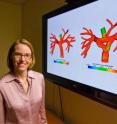UC San Diego engineer develops method to combat congenital heart disease in children
Congenital heart defects account for five times more deaths annually than all childhood cancers combined. Alison Marsden, an assistant mechanical and aerospace engineering professor at the University of California, has developed a unique set of computer modeling tools that are expected to enhance pediatric surgeons' ability to perform heart surgery on children. Marsden's work focuses on designing and using simulation tools to provide a way of testing new surgery designs on the computer before trying them on patients, much like, for example, engineers use computer codes to test new designs for airplanes or automobiles. Certain severe forms of congenital heart defects leave a patient with only one functional heart pumping chamber. These "single ventricle" defects are uniformly fatal if left untreated, and require a patient to undergo multiple heart surgeries, ending with a Fontan procedure.
In the Fontan surgery the veins returning blood to the heart from the body are directly connected to the arteries that send deoxygenated blood to the lungs, forming a modified t-shaped junction. This bypasses the heart on the one side so that the resulting circulation puts the single pumping chamber to optimal use. Using models derived from MRI image data, Marsden has come with a way to optimize a Y-Graft model for the Fontan procedure which can help pediatric surgeons determine whether this procedure will benefit a patient, as well as and determine how a patient's heart will perform during moderate exercise. Marsden's' research findings on the Y-Graft were published in a paper called, "Evaluation of a novel Y-shaped extracardiac Fontan baffle using computational fluid dynamics," in the February issue of the Journal of Thoracic and Cardiovascular Surgery.
An advantage of Marsden's proposed Y-Graft design is that it can be optimized or modified for an individual patient by custom manufacturing the graft portion prior to surgery.
"Our goal is to provide a set of personalized tools that can be used in collaboration with surgeons to identity the best procedure for patients," Marsden said.
Pediatric surgeons at Stanford University plan to use Marsden's Y-Graft computer models for a Fontan procedure for the first time later this year. One of the pediatric cardiologists working with Marsden is Dr. Jeff Feinstein, an associate professor of Pediatrics (Cardiology) at Stanford with a specialization in interventional cardiology, and director of the Vera Moulton Wall Center for Pulmonary Vascular Disease at Stanford.
"Alison's work enables us to look at things we can't look at in any other way," Feinstein said. "The whole concept of simulation based medicine offers opportunities to try things with zero risk to the patients. With this type of computer modeling, you can do 100 simulations before you ever try it in a patient."
Marsden has also been working with Dr. John Lamberti, a professor in the Department of Surgery at the UC San Diego School of Medicine.
"The research Alison is doing is very relevant to the treatment of the most complex forms of congenial heart disease," said Lamberti, also a pediatric cardiac surgeon and Director of the Heart Institute at Rady Children's Hospital. "This type of computer modeling could provide a patient with better long term cardiac performance and better exercise tolerance particularly during the teenage years and into adulthood when conventional-type Fontan procedures begin to fail."
Part of Marsden's work on the Y-Graft includes increasing flow rates to simulate exercise.
"These simulations allow us to obtain information that is difficult to measure in the clinic," Marsden said . "This way we can design something that would allow a patient to perform well at rest but also during exercise
Marsden – who joined the UC San Diego Jacobs School faculty in 2007 after receiving her Ph.D. at Stanford University – hopes to eventually apply her current research and computer models to a whole range of cardiovascular diseases both in children and adults.
"One of the reasons I came to UC San Diego was because it's a really great place to do this type of work," Marsden said. "We have one of the top bioengineering departments in the country, as well as a top mechanical engineering department and medical school. I had a lot of offers but I chose UC San Diego because of its strong combination of engineering and medicine expertise. San Diego also has a huge biotech presence, which is a plus for researchers in the region."


